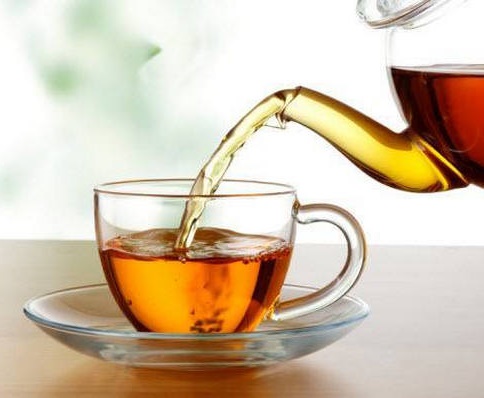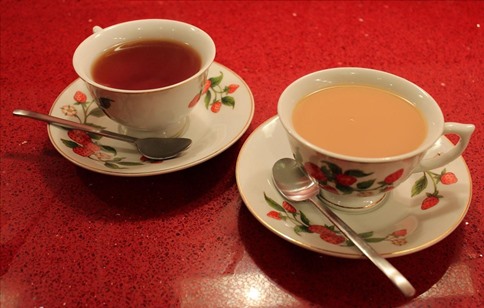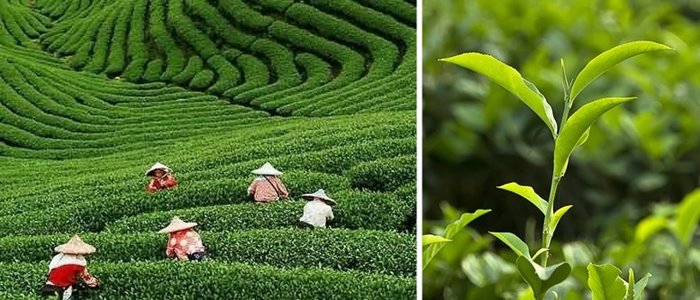Basic Rules for the Perfect Cuppa
The first misunderstanding stems from the belief that pouring hot water over herbs such as camomile, mint and rooibos or fruit such as rosehip constitutes making tea. Wrong! The resulting beverage is not tea. It is a herbal infusion or, as the French so nicely put it, tisane.
The Tea Plant
Only tea made from a tea plant can be called tea. Simple, isn’t it? Don’t let your hopes soar, though. We cannot escape ambiguities even when we focus on the tea plant.
Camellia sinensis (as is its Latin name) comes in several varieties, the best known being the small-leaved Chinese tea plant and the large-leaved Assam tea plant.
But that is not all. One and the same variety of Camellia sinensis will differ significantly from region to region. Even the same plant grown on two sides of a hill may produce distinct subtleties. In that respect, tea is like wine: its flavour and characteristics will change depending on the soil, altitude and climate.
The Tea Classification
Teas are classified according to region of origin, for example Chinese, Ceylon, Darjeeling or Assam tea. They are also classified by the size of the processed leaf. However, the most important classification of teas is by the processing method. Different experts have come up with different categories, but since tea is a Chinese invention, we will stick to the Chinese classification which recognises six broad types of tea:
The main difference between these different types is the level of oxidation. The moment a tea leaf is plucked off the bush, it starts to oxidise. This process influences the tea's flavour, so manufacturers monitor it closely. To stop the oxidation at the desired level, the leaves are heated by steaming or pan-firing.
White, green and yellow teas are barely oxidised. Oolong is oxidised anywhere from 20% to 80%. Black tea, which is currently the most popular type of tea, is fully oxidised. Dark teas such as Pu'erh are barely oxidised. Instead, they undergo microbial fermentation over many years, though most dark teas are nowadays ripened via an accelerated process lasting only several months. Good dark teas gain value with age.

Any of the above six tea types can be flavoured, scented, decaffeinated, and so on. Some tea experts group those teas into the seventh category, named altered teas.

The Tea Making Rules
Now comes the most difficult part: how to make the perfect cup!
There are many ways to make tea, and everyone thinks that their way is the right way. And we are not even talking about the elaborate tea rituals, but about the simple everyday business of preparing one of the world’s favourite beverages.
Still, there are several rules to proper tea making that practically everyone adheres to. Let’s concentrate on those first.
Water source: Tap water is fine, although some tea lovers prefer to use filtered or even bottled water. In any case, do not reheat the water that has been left to stand in the kettle. Use fresh water every time.
Tea quantity: When making tea for several people, use one level teaspoon of large tea leaves per cup, or a little less if the tea leaves are small. Do not add one for the pot.
Water temperature: Do not use boiling water. Black tea is best made with water heated to 85 or 95 degrees Centigrade, while green and white teas need the water heated up to 85 and 75 degrees respectively.
Seeping time: Allow the tea to seep for the appropriate amount of time, which can be up to five minutes for black and oolong teas and up to three minutes for green and white teas. The general rule here is: the smaller the tea leaves (or particles), the shorter the brewing time.
The Tea Making Controversies
Numerous controversies continue to simmer in the world of tea drinking. They can be roughly classified from minor to major in the following manner:
Lid on or off: Most people who use a teapot when making tea cover it during the brewing, but some tea lovers say it is better to leave the lid off so that the leaves get more oxygen.
Tea into water or water over the tea: The majority of tea drinkers pour hot water over tea leaves, but there are a few voices that advocate adding tea leaves to hot water.
Tea leaves or tea bags: Although tea leaves win in theory, it looks like a substantial number of tea drinkers are using the more convenient tea bags. If you are among them, remember to simply lift out the tea bag after the recommended brewing time (which will be shorter than the recommended brewing time for tea leaves). Do not squash the bag against the side of your cup, because this releases bitterness into the beverage.
To reuse or not: Tea leaves can be reused five or six times and tea connoisseurs say that the best beverage is achieved with the second or the third reuse. As for tea bags, some say that you can reuse them once or twice, others say: never. If you reuse your tea leaves or tea bags, do it within about three hours.

To sweeten or not to sweeten: While many tea drinkers are torn between sugar and honey, it is worth your while to train your palate to appreciate unsweetened tea. This is a healthier choice, and in due time you will find it tastes better too.
If you must have sugar, never dip into it the spoon with which you have stirred the tea. This will contaminate the sugar!
What about milk: Milk is the most hotly debated issue in the tea drinking world. The controversy is not so much about whether to use milk in your tea or not. After all, those who do it will continue to do it, and those who do not are not likely to venture that way.
The controversy is among the milk-in-the-tea crowd and it centres on this fundamental dilemma: should you add milk to the cup after or before you’ve poured the tea? The proponents of both after or before methods have put forward some powerful arguments, so the controversy seems destined to go on and on.
In any case, most agree on two points: one, that black teas withstand the addition of milk better than other teas; and two, that it does not make sense to waste money on a high quality tea if you are going to obliterate its flavour by adding milk to it.
It takes patience to train your palate to appreciate the subtleties of tea and to distinguish between different flavours and notes. You need to taste various kinds of tea and to alter the preparation method. Here are some of the tools to help you in your search for the perfect cuppa: kettle, tea pot , tea strainer, tea ball, tea infuser and, of course, tea bag holder.
When you find the winner, you will know it!
